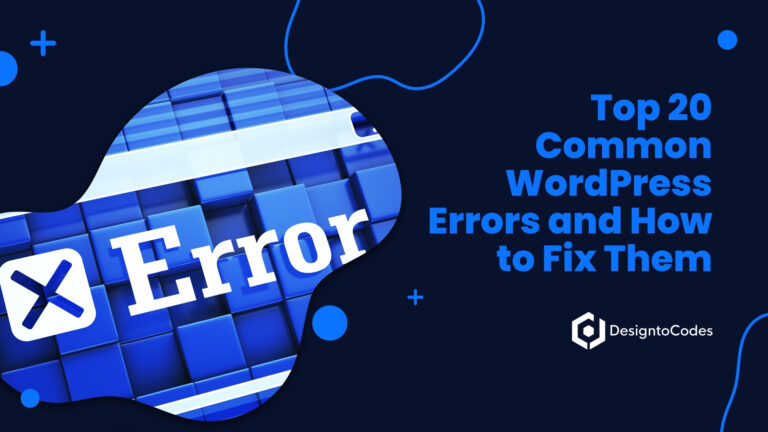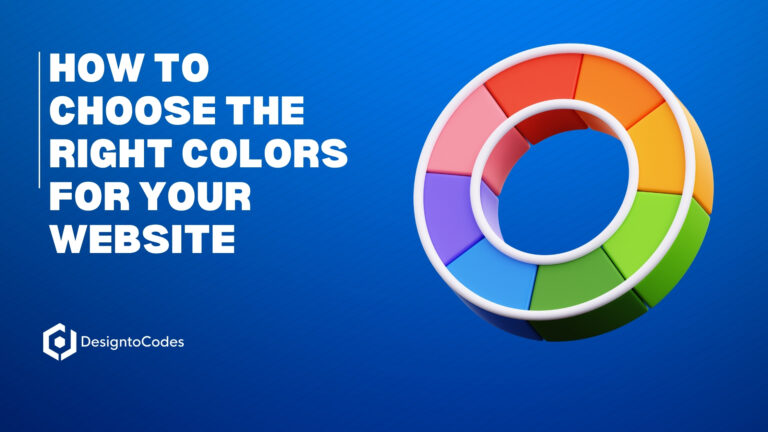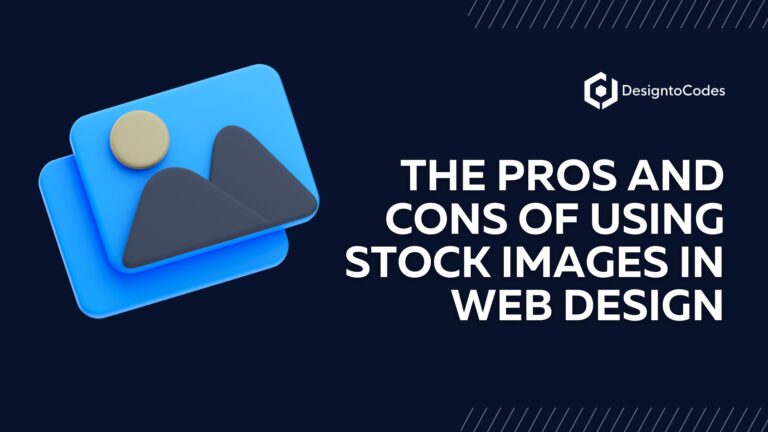
The Pros and Cons of Using Stock Images in Web Design

In the dynamic world of web design, visuals play a pivotal role in capturing attention, conveying messages, and enhancing user experience. Stock images—pre-existing, licensed photographs, illustrations, or graphics—are a popular choice for designers and businesses looking to create visually appealing websites without the expense of custom photography. However, while stock images offer significant advantages, they also come with challenges that can impact a website’s authenticity and effectiveness. This comprehensive guide explores the pros and cons of using stock images in web design, offering practical tips to help you make informed decisions for your next project on DesignToCodes.
Introduction to Stock Images in Web Design
Visual content is a cornerstone of effective web design, with 40% of consumers valuing images on a company’s website. Stock images provide an accessible solution for adding professional visuals to websites, from hero banners to product illustrations. Available through platforms like Unsplash, Pexels, and Shutterstock, these images cover a wide range of themes and styles, making them versatile for various industries. However, their widespread use raises questions about originality and relevance. This article delves into the benefits and drawbacks of stock images, helping you decide when and how to use them to create engaging, high-performing websites.
Pros of Using Stock Images
Stock images offer several advantages that make them a go-to choice for web designers, especially those working with limited resources. Here are the key benefits:
1. Cost-Effectiveness
Stock images are significantly more affordable than hiring a professional photographer or illustrator. Many platforms offer free images, while premium options are available through subscription models or one-time purchases, often costing less than $10 per image. This is a fraction of the cost of a custom photo shoot, which can range from $500 to $5,000 depending on the scope. For small businesses or startups, stock images provide a budget-friendly way to achieve a professional look without breaking the bank.
2. Time-Saving
Creating custom visuals requires planning, shooting, and editing, which can take days or weeks. Stock images, on the other hand, are instantly downloadable, allowing designers to integrate high-quality visuals into their projects within minutes. Sophisticated search tools on stock image platforms, using keywords, categories, or filters, make it easy to find relevant images quickly, streamlining the design process.
3. Variety and Quality
Stock image libraries boast millions of images covering diverse topics, from corporate settings to nature and technology. Many are captured by professional photographers, ensuring high resolution and excellent composition suitable for web use across devices. Whether you need a vibrant hero image for a landing page or a subtle background for a blog, stock images offer a wealth of options to suit various design needs.
4. Convenience
The ease of browsing, selecting, and integrating stock images makes them highly convenient. Designers can search for images that match their project’s theme or color scheme without coordinating photo shoots or managing production logistics. This convenience is particularly valuable for projects with tight deadlines or limited resources.
5. Legal Protection
When sourced from reputable platforms, stock images come with clear licensing agreements, ensuring legal use for personal or commercial projects. This protects designers and businesses from copyright infringement, provided they adhere to the licensing terms. Royalty-free licenses, for example, allow multiple uses without additional fees, offering peace of mind.
Cons of Using Stock Images
Despite their benefits, stock images have notable drawbacks that can affect a website’s effectiveness and brand perception. Here are the key challenges:
1. Lack of Uniqueness
Since stock images are available to anyone, they can appear on multiple websites, leading to a generic or homogenized look. This lack of originality can dilute a brand’s identity, especially in competitive markets where standing out is crucial. For instance, a widely used image of a “corporate handshake” may make your site feel impersonal and indistinguishable from competitors.
2. Overuse
Popular stock images, such as those depicting smiling teams or generic cityscapes, are often overused, reducing their impact. Web users are increasingly savvy and can recognize stock photos, which may lead to perceptions of inauthenticity. An X post by @robertodigital_ humorously noted that stock photo models often look like “confused interns,” highlighting how overused images can undermine credibility.
3. Relevance Issues
Finding stock images that perfectly align with your brand or content can be challenging. Stock photos are created for broad appeal, not specific projects, so they may lack the emotional depth or context needed to convey your message. For example, a healthcare website using a generic stock image of a doctor may fail to capture the unique ethos of the practice.
4. Cost of High-Quality Images
While many stock images are affordable, premium or exclusive images can be costly, with prices ranging from $20 to $100 or more per image. For websites requiring multiple high-quality visuals, these costs can add up, potentially rivaling the expense of a small custom photo shoot.
5. Licensing Complexities
Stock image licenses vary, with terms like royalty-free, rights-managed, exclusive, or non-exclusive use. Misunderstanding these terms can lead to legal issues, such as using an “editorial only” image for commercial purposes. Designers must carefully review licensing agreements to ensure compliance, which can be time-consuming and complex.
When to Use Stock Images
Stock images are ideal in specific scenarios where budget, time, or resources are limited. Here are situations where they shine:
-
Blogs and Articles: Stock images can illustrate concepts or add visual interest to blog posts, especially for general topics like technology or lifestyle.
-
Placeholder Content: During development, stock images serve as placeholders until custom visuals are ready.
-
Budget-Constrained Projects: Small businesses or startups can use stock images to achieve a professional look without significant investment.
-
Supplementary Visuals: Stock images work well for backgrounds, banners, or secondary visuals that don’t require brand-specific imagery.
Tips for Choosing Stock Images
-
Align with Brand: Select images that match your brand’s tone, colors, and style.
-
Avoid Clichés: Steer clear of overused images like generic handshakes or smiling call-center workers.
-
Customize When Possible: Crop, add filters, or overlay text to make stock images feel unique.
-
Use Sparingly: Combine stock images with original content to maintain authenticity.
When to Opt for Custom Photography
Custom photography is preferable in scenarios where authenticity and brand identity are paramount. Consider custom visuals for:
-
Product Showcases: E-commerce sites benefit from unique product images, as 67% of consumers say product images influence purchasing decisions.
-
Brand Identity: Custom photos of your team, office, or services create a personal connection with your audience.
-
Unique Storytelling: Custom visuals can convey specific narratives that stock images may not capture.
-
High-Stakes Industries: Sectors like healthcare or education require authentic imagery to build trust.
Benefits of Custom Photography
-
Uniqueness: Tailored to your brand, ensuring a distinct look.
-
Relevance: Captures the exact context and emotion needed.
-
Full Control: You own the images, with no licensing restrictions.
An X post by @vakninliorcom shared a case study of a roofer who doubled conversions by switching to real project images, underscoring the impact of custom visuals.
Impact on User Experience and Engagement
The choice between stock and custom images significantly affects user experience and engagement. Research suggests that original graphics drive 20% more engagement than stock photos, as they feel more authentic and relevant. Visitors spend an average of 5.94 seconds reviewing a website’s main image, making it critical to choose visuals that captivate immediately. However, poorly chosen stock images can harm perceptions, with 38% of users leaving sites due to poor design or content, including inauthentic visuals.
User Perception
-
Stock Images: Can appear staged or generic, potentially reducing credibility, especially in trust-based sectors like healthcare.
-
Custom Images: Convey authenticity, fostering trust and emotional connection.
Engagement Strategies
-
Use high-quality, relevant stock images to maintain professionalism.
-
Combine stock images with custom visuals to balance cost and authenticity.
-
Ensure images align with your website’s visual hierarchy to guide user attention.
Technical Considerations
Stock images, often high-resolution, can impact website performance if not optimized. Slow-loading images cause 39% of users to lose interest, and websites taking over two seconds to load may lose 60% of visitors. To mitigate this:
-
Optimize Images: Compress images to reduce file sizes without sacrificing quality.
-
Use Web-Sized Images: Resize images for web use to prevent pixelation or slow loading.
-
Implement Lazy Loading: Load images only when they enter the viewport.
-
Add Alt Tags: Include descriptive alt text for accessibility and SEO.
DesignToCodes templates are optimized for performance, ensuring stock images integrate seamlessly without compromising speed.
Legal Aspects
Using stock images requires understanding licensing terms to avoid legal issues. Common licenses include:
-
Royalty-Free: Allows multiple uses without additional fees, ideal for web design.
-
Rights-Managed: Restricts usage by time, location, or purpose, requiring careful review.
-
Editorial Use Only: Prohibits commercial use, suitable for blogs but not marketing.
An X post by @owen_roe emphasized using reputable platforms like Unsplash to avoid licensing issues with stolen images. Always verify licensing terms and keep records of purchases to ensure compliance.
Alternatives to Stock Images
To enhance authenticity and engagement, consider alternatives to stock images:
-
Illustrations: Custom or stock illustrations offer a unique, artistic look, ideal for creative websites.
-
Icons: Enhance usability and visual appeal, especially for navigation or infographics.
-
User-Generated Content: Customer photos or testimonials add authenticity and social proof, particularly for e-commerce.
An X post by @_SAMMYARTS highlighted the impact of quality stock images when color-graded and integrated thoughtfully, suggesting that creative use can bridge the gap between stock and custom visuals.
Comparison of Stock Images vs. Custom Photography
|
Aspect |
Stock Images |
Custom Photography |
|---|---|---|
|
Cost |
Generally cheaper, free options available |
More expensive, $500-$5,000+ per shoot |
|
Time |
Instant access, downloadable in minutes |
Requires planning, shooting, editing |
|
Uniqueness |
May be used by others, risks generic look |
Unique to your brand, highly distinctive |
|
Relevance |
May not perfectly match specific needs |
Tailored to exact requirements |
|
Quality |
Varies, many high-quality options |
Controlled quality, professional results |
|
Licensing |
Must adhere to licensing terms |
Full ownership, no restrictions |
Conclusion
Stock images are a valuable tool in web design, offering cost-effective, high-quality visuals that save time and ensure legal protection. However, their potential lack of uniqueness, overuse, and licensing complexities require careful consideration. By selecting relevant, high-quality stock images and combining them with custom visuals or alternatives like illustrations, you can create a website that is both visually appealing and authentic. DesignToCodes offers templates that integrate seamlessly with stock images, helping you balance cost, convenience, and creativity to build engaging websites that resonate with your audience.
- Categories: Reading
Share This Post
Subscribe To Our Newsletter
Get More Update and Stay Connected with Us





